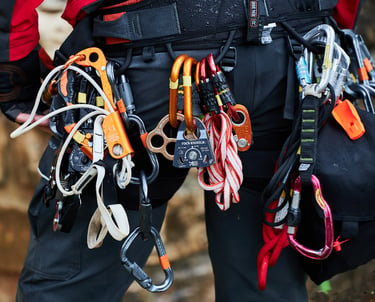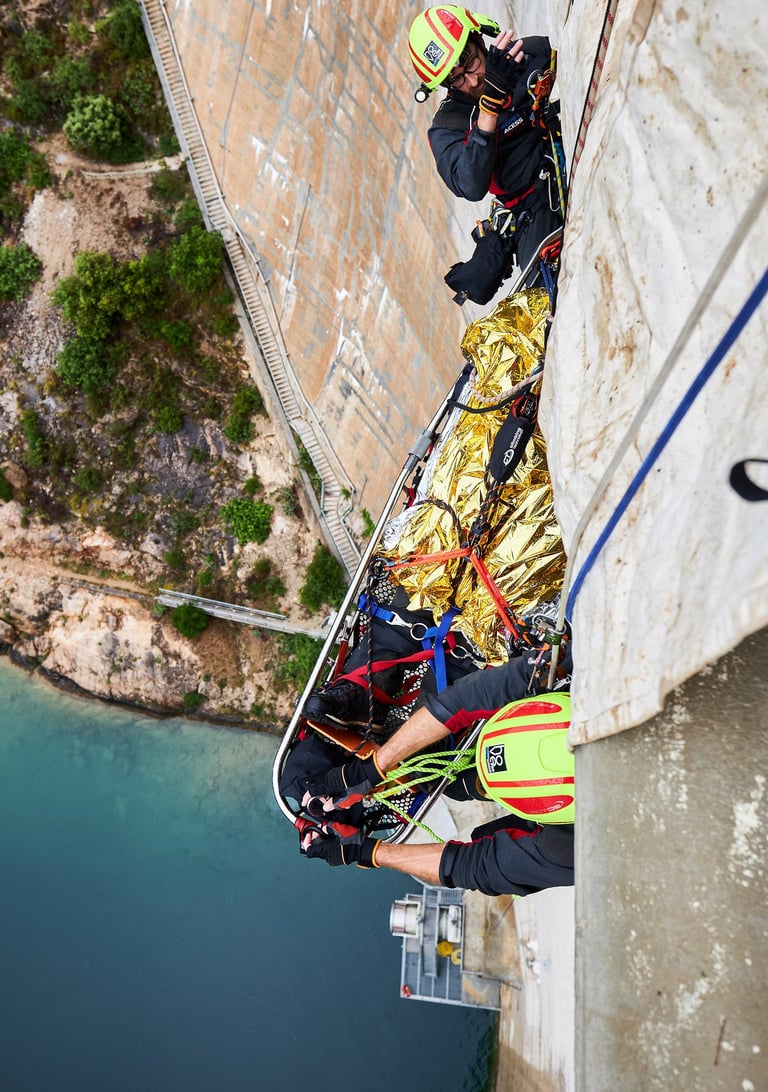Regulation/Rules (extracts)
Below you will find some elements of the Vertical Day regulations which will allow you to know how the competition works overall. Full and detailed regulations will be sent to the selected teams. The teams will find in it all the elements necessary for their good preparation for the competition.
The team
A team is made up of 7 people (1 team leader, 4 team members, 1 évaluator and 1 minimum 70kg victim). Each member of the team is able to constantly ensure their own safety, of their teammates and the victim.
The team leader function cannot be carried out by a person other than the one designated at the start of the competition. If a teammate abandons during the competition he/she cannot be replaced and cannot resume the competition.
Supports are available in French (official language of the competition) and in English. Non-French-speaking teams who wish can be accompanied by a translator. Please note: he must remain permanently with the team and with the evaluator (no interactions with the team without the evaluator's agreement and be able to ensure his own safety at height.
Each team must provide proof of insurance for activities related to the competition (proof requested in the final registration file).


Material
Each team is free to choose its individual and collective equipment.
It must have at least the mandatory equipment requested by the organization.
No material may be added or removed during the competition.
Use of motorized, manuals winches or high directional frames is forbidden (except if requested by the organization)
See bottom of the page (and the rules book which will be sent to the teams) for mandatory minimal material.
Autonomy and Security
Teams must have the technical level and equipment necessary to carry out any rescue mission in a perilous environment and to pack a victim in a suitable stretcher. The equipment must be mastered by all members of the team, be in good condition and meet current standards. All rope movements and load movements are carried out on the principle of permanent redundancy.
Neutral zone
Once their rescue is finished, the entire team immediately returns to the neutral zone with all of their equipment. This is a space accessible only to competitors, with no visibility into other scenarios or teams currently working. In order to avoid the transmission of information or the distribution of photos, mobile phones will be prohibited in this area.
Scenarios
A scenario is a situation that is presented to a team. This presentation is done with a simplified diagram which presents the location of the victim, the final arrival area of the victim and the particular constraints (position of the stretcher for example).
Evaluators present to each team leader the simplified diagram and give the specific elements. At the end, the timer is started and the team leader takes his teammates into account to begin the mission.
A maximum completion time is assigned to each scenario. A time barrier is indicated on each form. If the stretcher or the team has not passed this point at this time barrier, the team is stopped and must proceed to dismantling, repacking and returning to the neutral zone. Penalties are applied.
The scenarios are strictly identical in height, anchors, victim weight for each team
Evaluation - Ranking
Each scenario is evaluated by 1 or 2 technicians from the organization. The tests can be completed within the times set by the organization (carried out and validated by teams outside the organization).
The evaluation is made using 4 items :
Security
Professionalism of the team
Completion time
Specifics victimes criterias
Each item is the subject of sub-items.
At the end of each scenario, the score obtained is transmitted to the team.
The evaluation sheet will be presented to the teams during the briefing before the start of the competition.


Material (please note than this is the minimal required devices and this list will be updated)
Individuals PPE :
Helmet EN 397 ou EN 12492
Harness EN 361
Descender EN 341
Dispositif anti-chute EN 12841
Head lamp
Gloves, high shoes
Collectives PPE and devices :
6 ropes 100m (minimal diameter 10,5mm)
1 dynamic ropes EN 892 single 50m
1 stretcher able to be verticalisable
Big shot and devices for 50m
Collective devices
Evacuation triangle or harness to extract a victim
Victim :
Helmet
Harness EN 361 + double lanyard
Descendeur
Fall arrest
